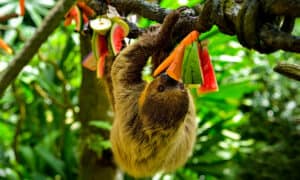When you think of a baby sloth, you probably picture a furry, lazy creature that loves to sleep. While it’s true that these fantastic animals lack the energy needed to engage in strenuous activity, they are far from boring. Let’s “hang” out and learn five astounding sloth pup facts with some adorable pictures!
#1: Baby Sloths Only Poop Once a Week
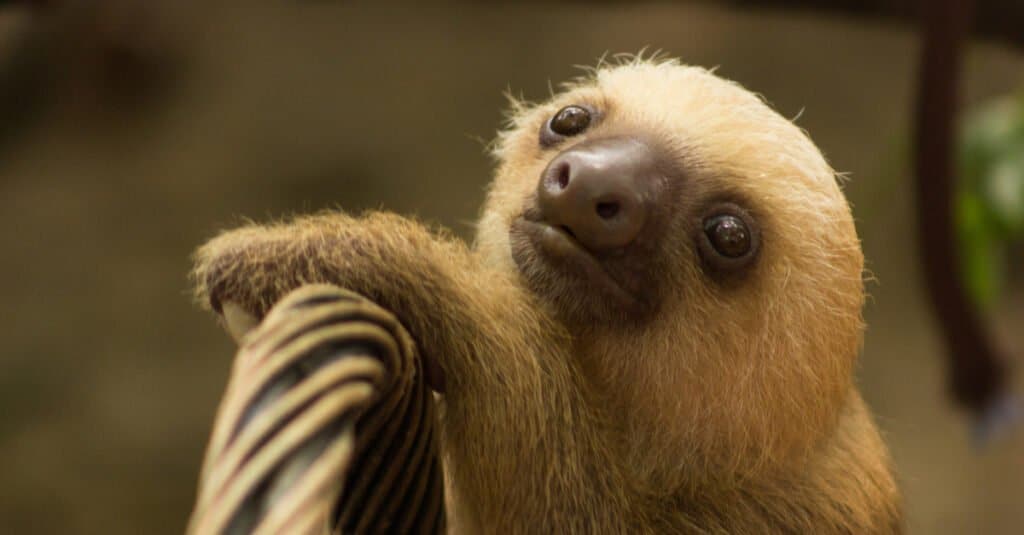
Sloth pups travel to the forest floor once a week to have a bowel movement.
©Kristen Pareti/Shutterstock.com
Can you imagine taking a single trip to the bathroom every seven days? For sloths, this is a reality. What’s more – every time they have a bowel movement, they lose up to a third of their body weight! The difference is so dramatic that if you were to witness it, you would see the tiny sloth’s stomach visibly shrink.
Another thing that makes sloth babies unique is how they poop. Sloths are arboreal animals, which means they make their homes high up in the trees. Other arboreal species, like monkeys, poop from their homes above the forest floor. Sloths, however, make the descent to the forest floor before conducting their business.
Even though baby sloths instinctually travel to the base of the trees for potty time, it’s a dangerous situation. Since they are slow-moving, small creatures, they are susceptible to many dangerous predators. Over half of sloth deaths to predators occur while sloths are near the forest floor.
#2: Sloth Babies May Spend Their Entire Lives in One Tree
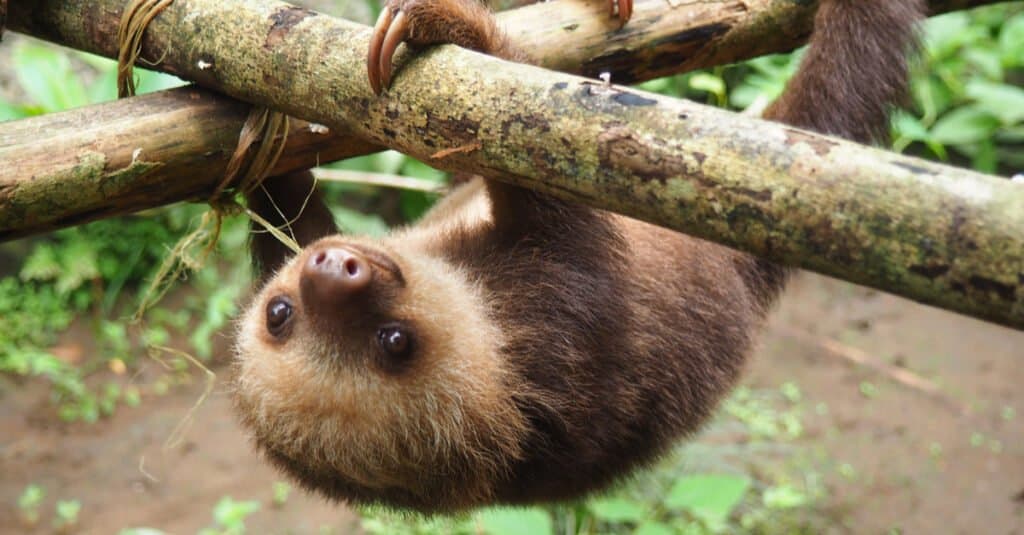
Sloths may never venture away from a single tree.
©Kristel Segeren/Shutterstock.com
Sloths are incredibly slow-moving creatures. One of the main reasons why this is true is because it takes a tremendous amount of energy for a sloth to do even the simplest of tasks. For example, a baby sloth may take over a month to digest just a single leaf!
Since sloths already spend a good portion of their energy traveling to the base of trees to poop once a week, there isn’t much energy left. To travel any distance, including between trees, would expend a tremendous amount of energy. Consequently, little energy would remain for daily tasks like eating and climbing.
For the first year of their lives, they reside in the same tree as their mothers. They cling to her fur for protection and start taking samplings of leaves at around a week old. After their first birthday, the young sloths venture off on their own to a new tree. However, that tree is usually just one or two trees away from the one their mother resides in.
#3: Only the Strongest Twin Pup Survives
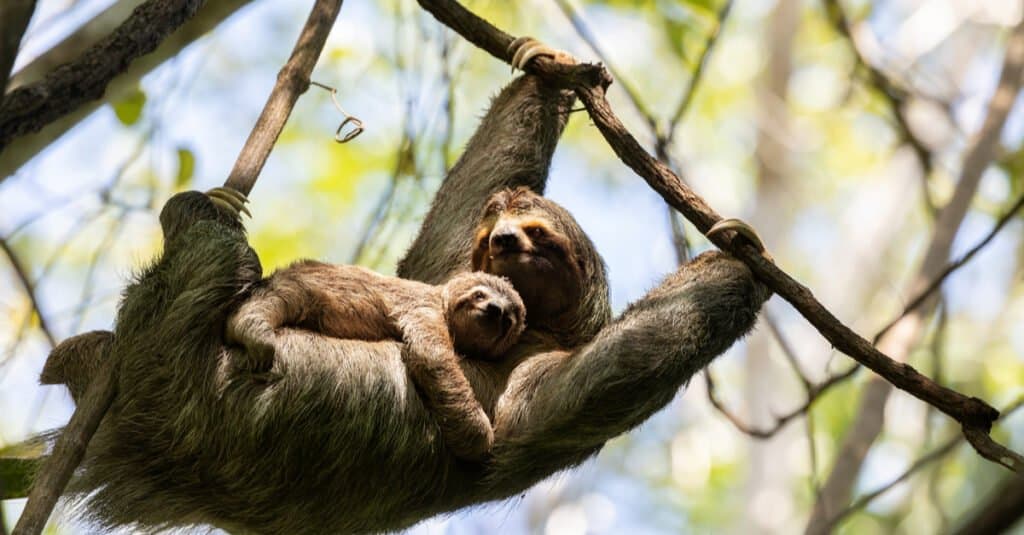
Mother sloths can only care for one baby at a time.
©Manamana/Shutterstock.com
Occasionally, a female sloth will give birth to a set of twin pups. However, the mother sloth only has enough room on her chest for one baby to cling to her for protection. In addition to this, mother sloths have limited energy to care for and bring up baby sloths.
Due to these circumstances, sloth pup twins cannot be raised simultaneously. Consequently, mother sloths routinely reject the weaker of the two babies. This gives the surviving tiny sloth the best chance at survival.
#4: Sloth Pups are Born Almost Completely Developed
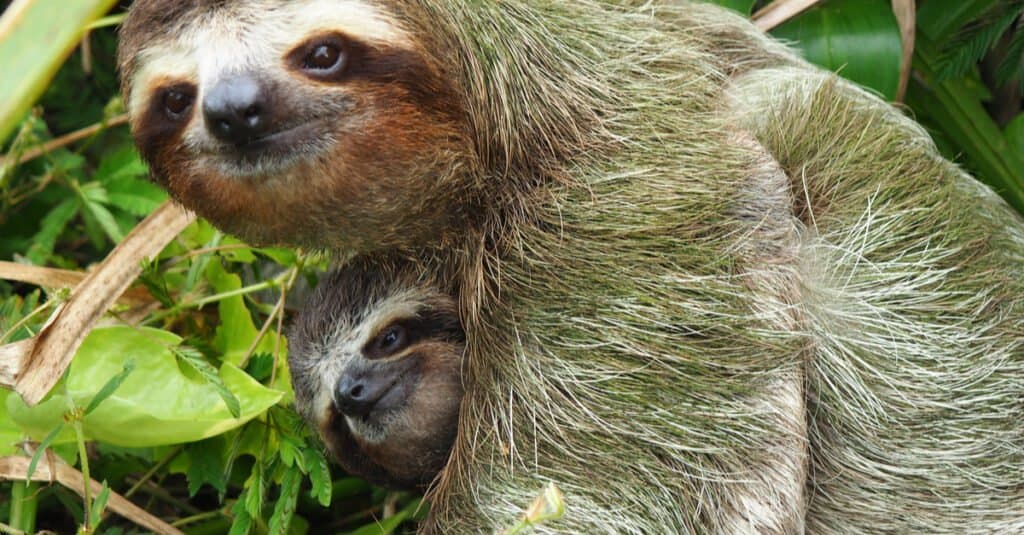
Sloth pups are able to cling to their mothers immediately after birth.
©Kristel Segeren/Shutterstock.com
When you think of a baby, you probably picture a tiny helpless animal. However, when it comes to sloth, that’s not the case. When baby sloths are born, their eyes are open, and they have a complete set of teeth and sharp claws. They can also instinctually climb upon birth.
Perhaps the most critical job of a sloth pup is to depend on its mother for survival. However, since female sloths have little energy, the newborn sloths can’t rely on her to protect them in a pinch. The solution? The babies cling tightly to the chest of their mother.
Sloth pups have extraordinary gripping power from the moment they are born. This evolution allows them to stay as safe as possible from predators since they stay safe and snug in their mother’s chest fur.
#5: Mother Sloths Raise Their Babies Alone

Mothers are solely responsible for raising sloth pups.
©Kristel Segeren/Shutterstock.com
If there’s a common theme in the animal kingdom, it’s this: father sloths don’t participate in raising their young. This means that the mother solely cares for her young for the first year of a baby sloth’s life.
Sloth pups spend a majority of their time clinging to their mother’s chest. From this position, they can nurse without expending too much energy to do so. Female sloths don’t store large amounts of milk to feed their young, unlike other mammals. Instead, they produce smaller amounts of milk at multiple intervals throughout the day to save energy.
The photo featured at the top of this post is © Kristen Pareti/Shutterstock.com
FAQs (Frequently Asked Questions)
How much do baby sloths weigh?
Baby sloths weigh around 10 ounces at birth.
What do baby sloths eat?
Sloth pups survive exclusively on their mother’s milk for around the first week of life. After a week, they start licking food out of their mothers’ mouths and taking small samplings of leaves. Sloths enjoy a blended diet of milk and leaves for around the first six months of their lives. After they are weaned from their mother’s milk, a baby sloth’s favorite food is leaves.
Where do baby sloths live?
Baby sloths live in Central and South America.
What are baby sloths called?
Baby sloths are called pups.
Thank you for reading! Have some feedback for us? Contact the AZ Animals editorial team.




